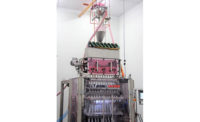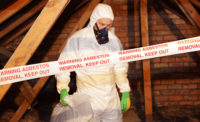More than 40% of the OSHA compliance officers who inspect America’s workplaces are industrial hygienists (OSHA.gov). Industrial Hygiene (IH) is the practice of regulating, anticipating, evaluating and participating in the prevention of hazards within the workplace that will affect the wellbeing of workers.
Health and safety hazards cover a wide-range of physical, chemical and biological stressors which may cause sickness, impaired health or significant discomfort among workers or citizens of your community.
There are numerous hazards that can exist between employees who work with chemicals, pathogens and contaminants. Setting practice controls ensure that the environmental and physical hazards are best taken care of in a developed and mandated setting.
Some types of hazards, as categorized by OSHA1, are:
Environmental
Air contaminants are classified by OSHA in their IH guidelines as either particulate or gas and vapor contaminants. OSHA states that the most common particulate contaminants are:
- Dusts
- Fumes
- Mist
- Aerosols
- Fibers
- Gases
- Vapors
Chemical
OSHA considers chemical hazards as vapors exerted by inhalation, absorption, ingestion or are airborne. The degree of worker risk varies with exposure to any substance and depends on the nature and potency of the toxic effects and magnitude of exposure.
Biological
Bacteria, fungi, viruses and other living organisms are considered biological hazards. OSHA states that such organisms can cause acute and chronic infections either directly or through breaks in the skin.
Physical
OSHA refers to excessive levels of ionizing and non-ionizing electromagnetic radiation, noise, vibration, illumination and temperature as physical hazards. Danger from radiation increases with the amount of exposure time.
Ergonomic
The science of ergonomic studies as reported by OSHA evaluates a full range of tasks including and not limited to—holding, lifting, pushing, walking and reaching.
How to Identify Hazards
It is important to note that a hazard is something that has the potential to cause harm. Jeffery Dalto via Convergence Training, notes these three facts about hazards:
- A hazard is not the same thing as the injury or illness itself
- A hazard may never cause an injury or an illness (even though it has potential to)
- Identifying hazards before they cause harm gives a chance to remove or reduce potential for harm
The Hierarchy of Controls
Dalto also explains the hierarchy of controls and why they are ordered the way that they are. He states, "if elimination isn’t possible or feasible then you should continue down the list trying substitution, then engineering controls, administrative controls and finally, as a last resort PPE.”
Controls for IH Hazards
According to OSHA, recognizing and working to control hazards are the primary means of reducing employee exposure to occupational hazards.
Here are three types of controls that are listed by OSHA that when practiced help minimize exposure:
1.Engineering Controls
Engineering controls are placed in effort to reduce or remove the hazard at the source by isolating the worker from the hazard. For example, eliminating toxic chemicals and substituting non-toxic chemicals, enclosing work processes or confining work operations and the installation of general and local ventilation systems.
2.Work Practice Controls
Fundamental controls include adjusting work practices to follow procedures that will minimize exposures during production, putting in place good housekeeping processes, effective supervision and mandating that certain behaviors in regulated areas are prohibited.
3.Administrative Controls
Administrative controls exist in the form of scheduling production and tasks to minimize exposure levels.
An Industrial Hygiene Module
An Industrial Hygiene module allows companies to perform qualitative assessments using Similar Exposure Group (SEG) methodologies for the categorization of hazard types, job roles, processes, locations and other demographics. Through IH qualitative methods, it is possible to create sampling plans, track results, monitor and perform calculations (TWA) and compare to threshold limits (PEL), (STEL) and targets as part of compliance determination needs.
Companies who use IH modules gain the ability to prioritize information and control health risks through data analysis and enhanced reporting. Linkage and oversight of testing equipment through Assets, Calibration and Maintenance along with tables and references for OELs, PELs, STELs and more determinations for compliance helps workers operate at a comfortable yet productive pace to protect against incidents, accidents and hazards.
Other Tools that Assist with Setting Controls
Emissions Inventory Module
An Emissions Inventory (EI) solution is one of the many tools that assist in improving air quality and EHS and sustainability regulations. An Emissions Inventory module calculates the volume of air pollutants charged into the atmosphere during a specific time period and then is able to generate reports surrounding the pollutants. EI allows companies to comply with air pollutant and emission regulations as well as permit requirements around the world by calculating at high volume on an on-going basis to ensure accuracy.
Chemical Compliance Module
A chemical compliance solution allows companies to oversee all chemical activities within all locations through the chemical approval process. Chemical compliance involves the creation and management of Safety Data Sheets (SDS), transportation and management of dangerous goods, labeling and packaging along with hazard classification and any part of the supply chain with dangerous goods or chemical products.
Job Safety Analysis
Job Safety Analysis (JSA) breaks down job positions into various operational steps to better analyze each action. Organizing job tasks within the EHS environment helps to teach—correct work practices, set appropriate engineering controls, evaluate work conditions from an ergonomics standpoint and determine the physiological and psychological demands of each worker to lower operating costs, achieve more effective use of personnel and ensure fewer accidents.
JSA is one of the many tools able to rank and determine risks and then assign Personal Protective Equipment (PPE) for job functions.
Safety Data Sheet Software (SDS)
Safety Data Sheet (SDS) software allows an organization to store documentation that relates to the safe disposition of its products and components which require specific handling and instructions.
SDS links proper methods and sources of HAZMAT documents as well as SDS documents for storage. SDS benefits fire fighters, hazardous material crews, emergency technicians and room personnel as well as employees who may be exposed to specific hazards in their daily routine.
Employee Training
Employee training helps to build out a training plan for each employee or group with certain requirements for each. It allows new documents or processes to be updated and put into formation with little to no delay. Training within an EHS organization, where there are potential hazards at arms-length daily is crucial.
OSHA states that where there is potential exposure to biological hazards, workers should practice proper personal hygiene, ventilation, PPE, adequate waste disposal systems and appropriate controls including isolation in instances of particularly contagious diseases.
The goal of an industrial hygienist, according to AIHA is to keep workers, their families and the community healthy and safe. They must ensure that federal, state and local laws and regulations are followed in the work environment.
Optimizing risk management and employee training using components of industrial hygiene within and EHS organization can help control potential hazards that might impact workers, the environment and an organization.
Risk Management
An employee’s risk of a hazard is determined first by their nature and potency, as well as the effects, magnitude and duration of exposure.
How you manage risk has a direct impact on the economic performance and reputation as well as environmental, safety and societal outcomes. Operational Risk Management solutions work to register, assess, respond and treat risks to decrease the likelihood of occurrence.
Risk Assessment and risk register tools along with corrective action linked to document control help improve the identification of opportunities and threats that effectively allocate resources for treatment.
Behavior Based Safety (BBS)
A Behavior Based Safety program is proactive in nature. BBS examines leading indicators to ensure a healthy safety culture by focusing on the process rather than the outcome and attributes positive activators to produce behavior modification.
BBS allows for a fully customizable observation event that effortlessly works to improve safety performance in the workplace with risk assessment, risk rankings, assigning actions and preventive actions and reporting on incidents and trends.
Audit Management
Audit Management is an excellent tool to ensure that all hazard areas are examined and controlled. Monitoring air ventilation, noise extremes, environmental bacteria, administrative controls and PPE hazards creates a healthy and safe operating environment.
After a hazard is identified, actions can be taken to substitute a chemical for one that is less hazardous, improve ventilation or adjust equipment.
Closing Thoughts
Engaging in activities within the workforce can differ from day to day, as can hazardous outcomes. It is important to build methods of risk and sustainability into organizations so that operating under corporate, regulatory and social demands are met with ease.
Different tools offer solutions to manage the governance and risks that come with quality and compliance organizations to best fit specific business needs.
References



